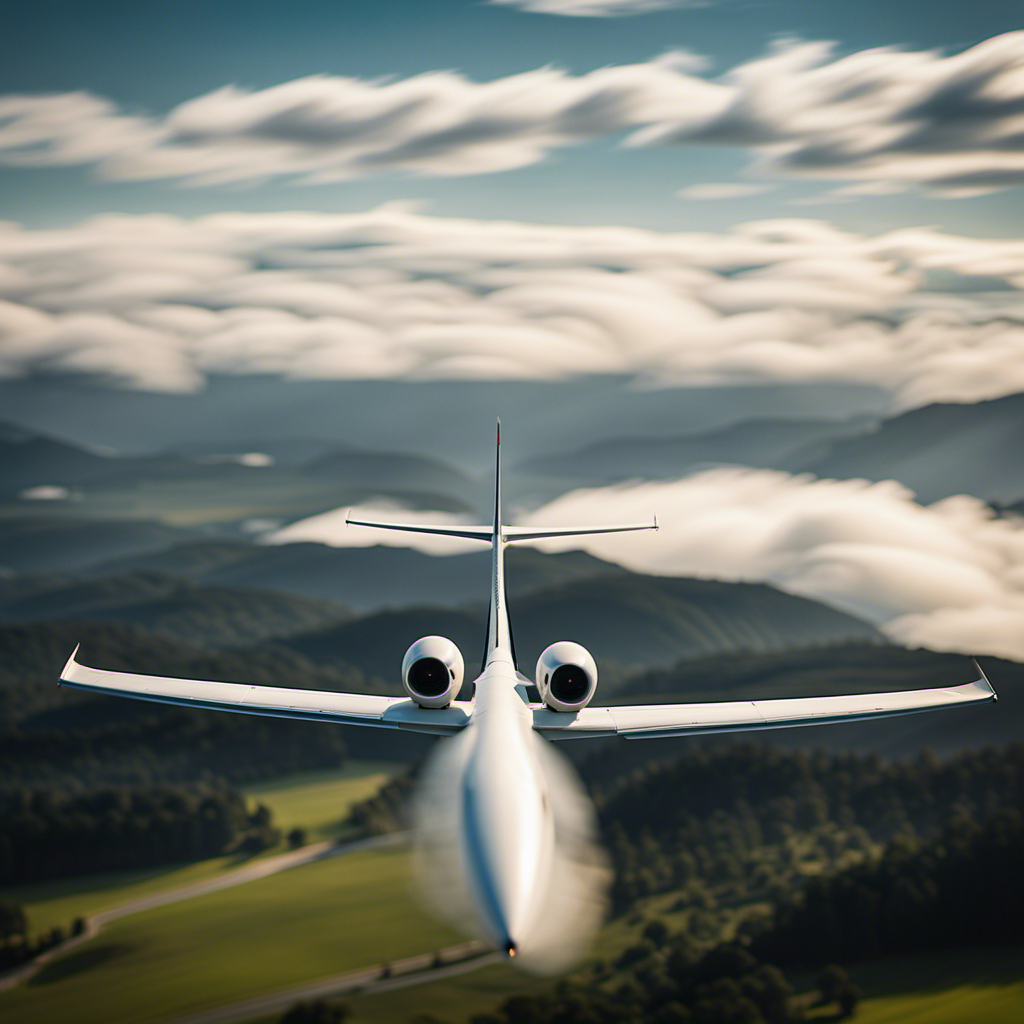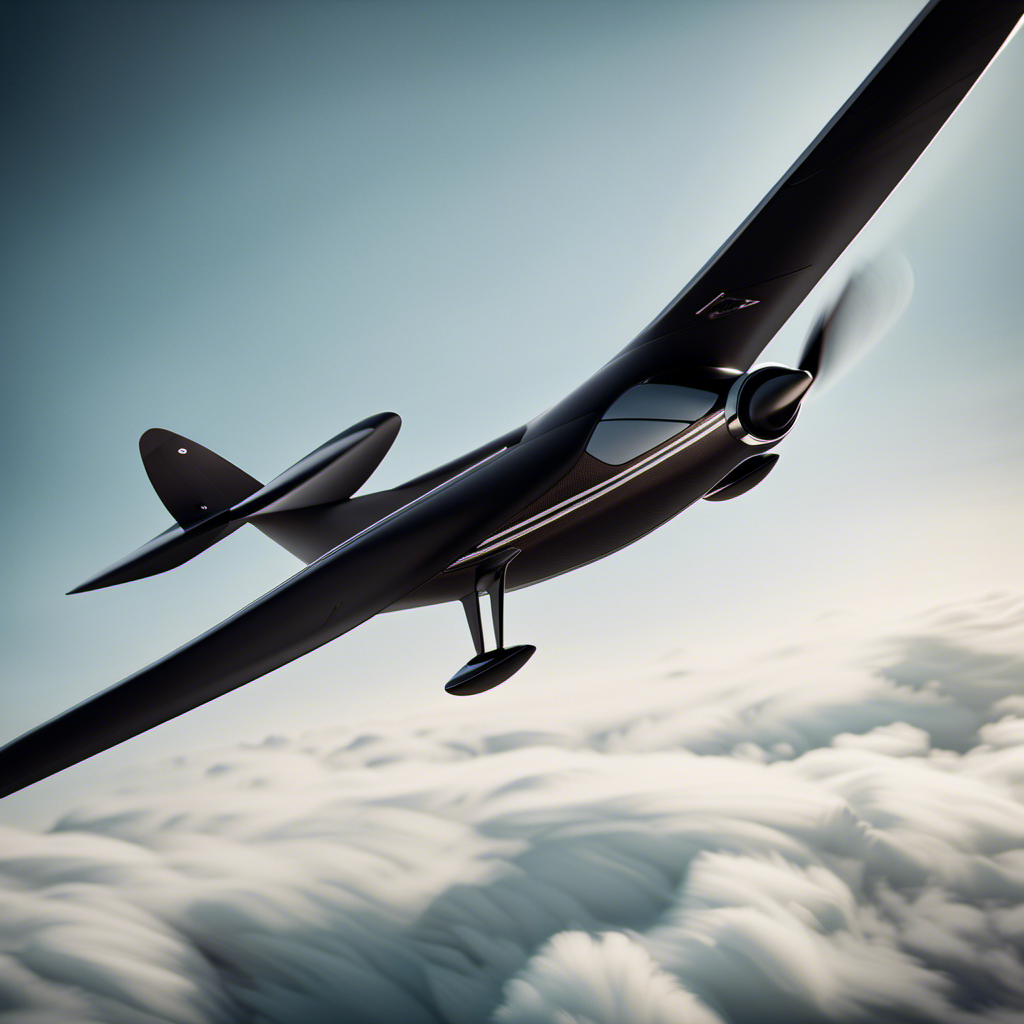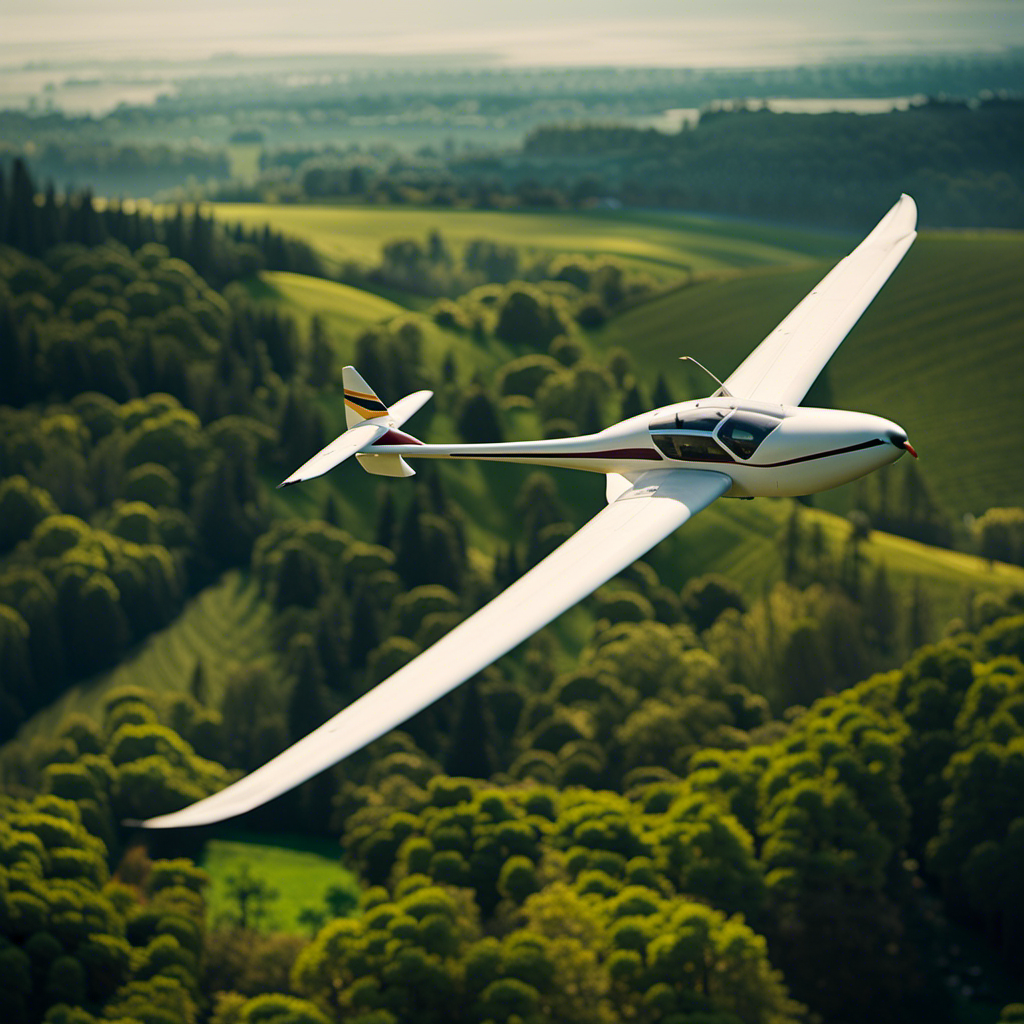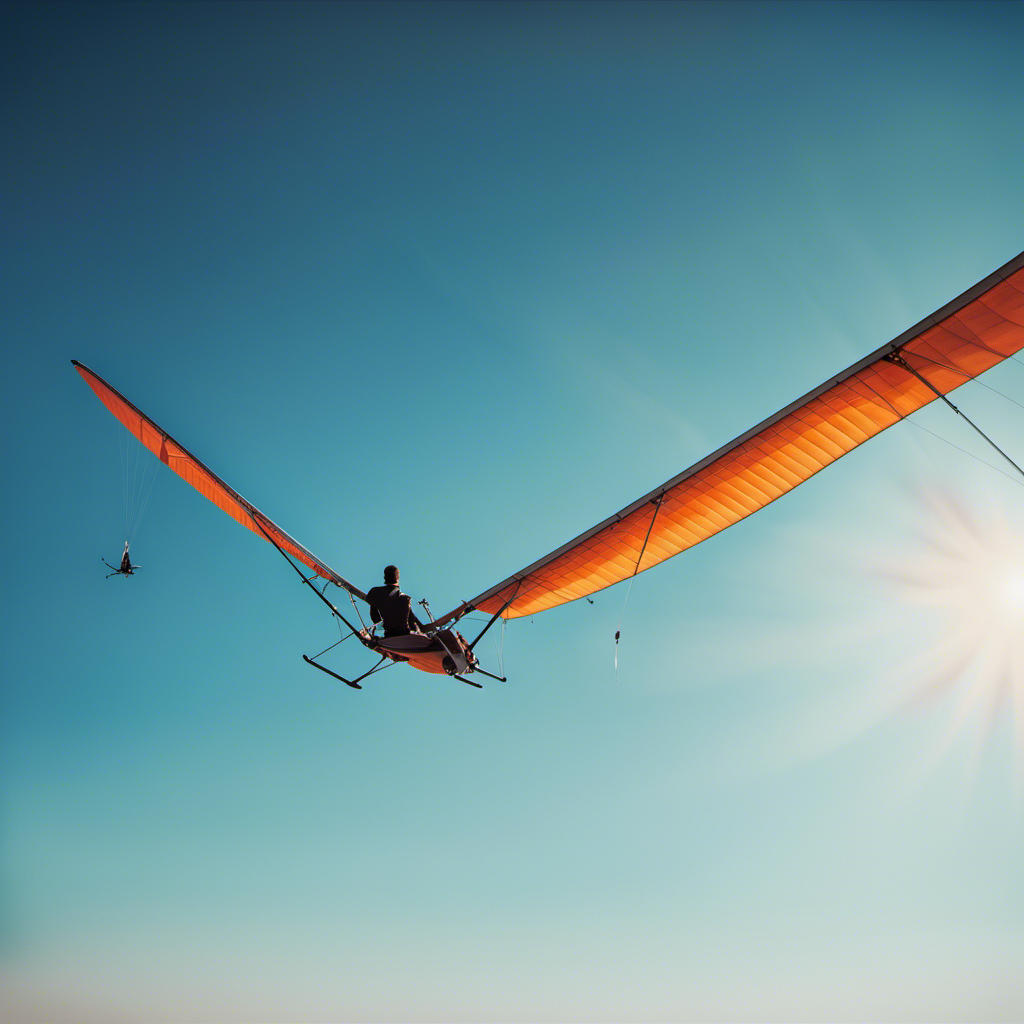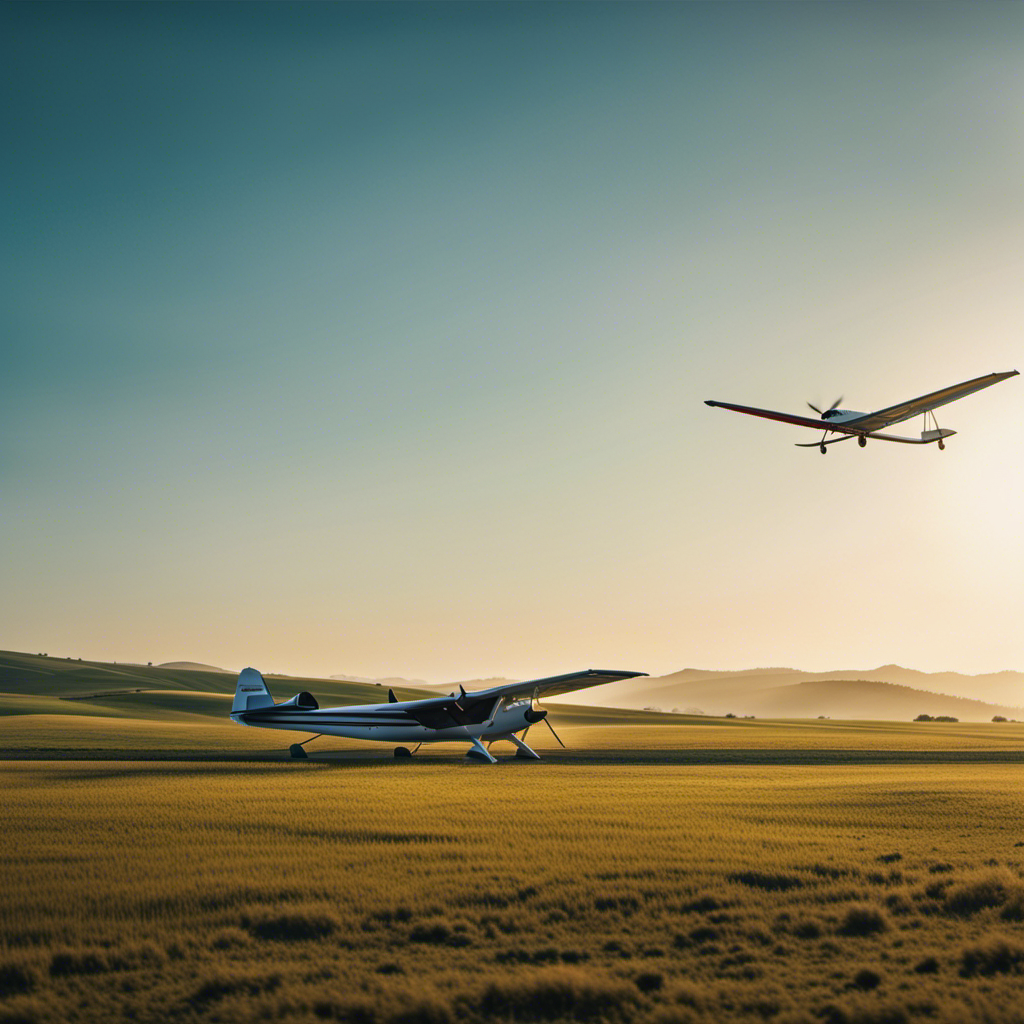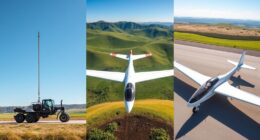Are you interested in learning about the factors that affect a sailplane’s glide ratio? Look no further!
In this article, we will delve into the intricacies of glide rate, exploring the factors that affect it and how to calculate it.
Discover the significance of glide rate in maximizing sailplane performance and its application in cross-country flights.
With safety considerations in mind, we will also provide tips on improving your sailplane’s glide rate.
Get ready to harness the power of glide rate in sailplane flying!
Key Takeaways
- The glide rate of a sailplane is important as it determines the distance covered without additional lift or propulsion.
- Maintaining the optimal speed for the best glide rate allows for maximum efficiency and increases glide distance.
- Efficient energy management, including utilizing thermals, ridge lift, or wave lift, helps to extend the glide and conserve energy.
- Safety considerations, such as planning for emergency landings and being prepared for unexpected situations, are crucial when considering the glide rate of a sailplane.
Understanding the Basics of Glide Rate
To understand the basics of glide rate, you need to know how airspeed and angle of attack affect the performance of a sailplane.
Airspeed refers to the velocity at which the sailplane is flying through the air. It directly affects the lift generated by the wings. Increasing airspeed increases the lift, allowing the sailplane to maintain altitude or even climb. On the other hand, decreasing airspeed reduces lift, causing the sailplane to descend.
The angle of attack, on the other hand, refers to the angle between the wing chord line and the oncoming airflow. A higher angle of attack increases lift but also increases drag. These two factors, airspeed and angle of attack, play a crucial role in determining the glide rate of a sailplane.
Moving on to the factors affecting glide rate, there are several other key aspects to consider.
Factors Affecting Glide Rate
One of the factors that affects how far a sailplane can travel without an engine is its wing design. The shape and size of the wings greatly influence the glide rate, which is the distance a sailplane can cover horizontally for every unit of altitude it loses. To better understand how different wing designs impact glide rate, let’s take a look at the following table:
| Wing Design | Glide Rate | Emotional Response |
|---|---|---|
| High Aspect Ratio | Long Distance | Excitement |
| Low Aspect Ratio | Short Distance | Disappointment |
| Variable Camber | Adjustable Distance | Flexibility |
As you can see, the wing design plays a crucial role in determining the sailplane’s performance. Now, let’s move on to calculating the glide ratio, which further enhances our understanding of a sailplane’s capabilities.
Calculating Glide Ratio
In order to understand the concept of calculating glide ratio, it is important to familiarize yourself with the glide polar curve and L/D ratio.
The glide polar curve is a graphical representation of the relationship between airspeed and glide ratio for a specific aircraft. It provides valuable information about the efficiency of the aircraft during gliding.
The L/D ratio, on the other hand, is the ratio of lift to drag and is a measure of the aerodynamic efficiency of the aircraft.
Glide Polar Curve
You can determine the glide rate of a sailplane by analyzing the shape of the glide polar curve. This curve represents the relationship between the aircraft’s sink rate and its airspeed.
The glide polar curve is obtained by conducting a series of glide tests at different airspeeds and recording the corresponding sink rates. By plotting these data points on a graph, you can observe the shape of the curve.
The glide rate is then determined by the slope of the curve, which represents the glide ratio (L/D ratio) of the sailplane. The L/D ratio is a measure of how efficiently the sailplane can convert altitude into distance traveled.
A higher L/D ratio indicates a more efficient glide and a greater distance covered for a given loss of altitude.
L/D Ratio
To improve your flying efficiency, aim for a higher L/D ratio. This ratio represents how efficiently your aircraft can convert altitude into distance traveled. It is calculated by dividing the lift generated by the aircraft by the drag it experiences.
A higher L/D ratio means that your aircraft can glide further for a given amount of altitude loss. This is crucial in sailplane performance as it allows you to cover more ground without losing too much altitude. The glide rate of a sailplane is directly influenced by its L/D ratio.
Importance of Glide Rate in Sailplane Performance
The importance of glide rate in sailplane performance cannot be overstated. Achieving maximum glide rate is crucial for a successful flight as it allows the sailplane to cover the greatest horizontal distance while descending the least amount vertically.
To understand why glide rate is so important, consider the following:
-
Glide rate directly impacts the efficiency of the sailplane’s flight. A higher glide rate means the sailplane can stay airborne for longer periods, maximizing its range.
-
The glide rate determines the sailplane’s ability to soar. A sailplane with a higher glide rate can stay within rising air currents, known as thermals, allowing it to gain altitude and extend its flight time.
-
Glide rate affects the sailplane’s ability to navigate obstacles, such as mountains or other airspace restrictions. A higher glide rate provides the pilot with more options for safe navigation.
Achieving maximum glide rate requires a combination of factors, including proper weight distribution, wing design, and pilot technique.
Achieving Maximum Glide Rate
Achieving maximum glide rate in a sailplane is essential for optimizing performance and maximizing flight time. To achieve this, there are several factors to consider.
First, you need to ensure that your sailplane is properly trimmed, with the center of gravity in the correct position. This will help reduce drag and allow for a smoother flow of air over the wings.
Additionally, controlling airspeed is crucial. Flying at the optimal airspeed for your sailplane will help minimize drag and maximize lift.
Lastly, maintaining a proper attitude and making small adjustments to the controls can help you find the sweet spot where your sailplane achieves its maximum glide rate.
Understanding and implementing these techniques will allow you to get the most out of your sailplane’s performance.
Now, let’s explore the variations in glide rate among different sailplane models.
Variations in Glide Rate Among Different Sailplane Models
Among different sailplane models, there are variations in how efficiently they glide. The glide rate of a sailplane refers to the distance it can travel horizontally for every unit of altitude it loses. This rate is influenced by various factors, including the sailplane’s design, wingspan, weight, and aerodynamic properties. To illustrate the differences in glide rates among sailplane models, consider the following table:
| Sailplane Model | Glide Rate (meters) |
|---|---|
| Model A | 40 |
| Model B | 50 |
| Model C | 60 |
| Model D | 70 |
| Model E | 80 |
As you can see, each model has a different glide rate, with Model E having the highest rate of 80 meters. Understanding these variations can help you choose the most suitable sailplane for your needs. It is important to note that the glide rate plays a crucial role in cross-country flights, as it determines how far you can travel without using any additional power.
Using Glide Rate for Cross-Country Flights
Now that you understand the variations in glide rate among different sailplane models, let’s delve into how you can utilize glide rate for cross-country flights.
When embarking on a cross-country flight, the glide rate of your sailplane is a vital factor to consider. It determines the distance your sailplane can cover without any additional lift or propulsion. By maximizing your glide rate, you can extend your flight time and cover longer distances.
Here are two important considerations when utilizing glide rate for cross-country flights:
-
Optimal Speed: Maintaining the optimal speed for your sailplane is crucial to achieve the best glide rate. Strive to fly at the speed that produces the highest lift-to-drag ratio, known as the best glide speed.
-
Energy Management: Efficiently managing your energy during the flight is essential. This includes utilizing thermals, ridge lift, or wave lift to gain altitude and extend your glide. It is important to conserve energy by avoiding unnecessary maneuvers or steep descents.
By understanding and implementing these considerations, you can effectively utilize glide rate for successful cross-country flights.
As you embark on your cross-country journey, it is important to consider safety factors and the impact they have on your sailplane’s glide rate.
Safety Considerations and Glide Rate
When it comes to emergency landings, planning for contingencies is crucial.
As a pilot, you must always be prepared for unexpected situations that may require you to land the aircraft in less than ideal conditions.
This means having a solid understanding of emergency procedures, being familiar with potential landing sites along your route, and continuously assessing the situation to make the best decision for a safe landing.
Emergency Landings
If you need to make an emergency landing in a sailplane, remember to remain calm and assess the best possible landing spot. Here are four important considerations to keep in mind:
-
Airspeed: Maintain the recommended airspeed for your sailplane to ensure a safe descent and control during the landing.
-
Terrain: Look for an open area with minimal obstacles such as trees, power lines, or buildings. A flat or gently sloping terrain is ideal.
-
Wind direction: Determine the wind direction and choose a landing spot into the wind. This helps reduce groundspeed and provides better control during touchdown.
-
Potential hazards: Be aware of any potential hazards in the landing area, such as soft or uneven ground, water bodies, or other aircraft.
By carefully evaluating these factors, you can increase your chances of a successful emergency landing.
Now, let’s move on to planning for contingencies and ensuring your safety in unexpected situations.
Planning for Contingencies
In case of an emergency, it’s important to have a plan in place to ensure your safety and handle unexpected situations.
One key aspect of planning for contingencies in a sailplane is to familiarize yourself with the emergency procedures outlined by the manufacturer. This includes knowing how to handle various scenarios such as loss of altitude, engine failure, or sudden weather changes.
Additionally, it’s crucial to have a thorough understanding of the local airspace regulations and emergency landing sites.
By having a well-thought-out plan, you can make quick and informed decisions during emergencies, increasing your chances of a safe outcome.
Now, let’s explore how you can improve your sailplane’s glide rate to maximize your chances of reaching a safe landing spot in case of an emergency.
Improving Your Sailplane’s Glide Rate
To improve your sailplane’s glide rate, you should focus on reducing drag and optimizing your weight distribution. By implementing the following strategies, you can maximize your sailplane’s efficiency and enhance your flying experience:
- Streamline your sailplane: Minimize unnecessary protrusions and ensure a smooth surface to reduce drag.
- Maintain proper wing and control surface alignment: A misaligned wing can cause unnecessary drag and decrease your glide rate.
- Optimize weight distribution: Ensure your sailplane is properly balanced to achieve optimal performance.
- Use efficient airfoils: Choose airfoils that provide maximum lift with minimum drag to improve your sailplane’s glide rate.
By implementing these techniques, you can significantly improve your sailplane’s glide rate and enhance your overall flying experience.
Harnessing the power of glide rate in sailplane flying allows you to cover more distance and explore the skies with greater efficiency.
Conclusion: Harnessing the Power of Glide Rate in Sailplane Flying
Now that you’ve learned about the various methods to improve the glide rate of your sailplane, it’s time to harness the power of glide rate in your flying.
By understanding the concept of glide rate and how it affects your overall performance, you can make informed decisions during your flights.
Manipulating your sailplane’s glide rate allows you to maximize your range, efficiency, and endurance in the air.
Remember to always consider the environmental factors, such as wind conditions and thermals, as they greatly influence your glide rate.
Utilize your knowledge of weight and balance, as well as optimizing your airspeed and flight path, to achieve the desired glide rate for your specific goals.
With practice and experience, you’ll become adept at utilizing the power of glide rate to enhance your sailplane flying adventures.
Frequently Asked Questions
What are the different types of sailplanes available in the market?
There are various types of sailplanes available in the market, each designed for specific purposes. These include training sailplanes, aerobatic sailplanes, high-performance sailplanes, and motorized sailplanes, among others.
Can the glide rate of a sailplane be improved with modifications or upgrades?
To enhance the glide rate of a sailplane, various modifications and upgrades can be implemented. By refining the airfoil shape, reducing drag-inducing components, and optimizing weight distribution, the glide performance can be substantially improved.
Are there any specific techniques or strategies to maintain a consistent glide rate during cross-country flights?
To maintain a consistent glide rate during cross-country flights, utilize techniques such as optimizing airspeed, selecting efficient flight paths, and managing energy effectively. These strategies help maximize the efficiency and performance of the sailplane throughout the journey.
How does wind speed and direction affect the glide rate of a sailplane?
Does the wind’s speed and direction determine how far a sailplane can glide? Yes, it does. Wind can either extend or shorten the glide of a sailplane, affecting its ability to cover distance during flight.
What are the potential risks or dangers associated with flying at low glide rates?
Flying at low glide rates in a sailplane can be risky due to reduced maneuverability and limited ability to maintain altitude. It increases the chances of stalling, making it harder to recover and potentially leading to a crash.
Conclusion
In conclusion, understanding and maximizing the glide rate of a sailplane is crucial for optimal performance in the air. By calculating and improving the glide ratio, pilots can achieve longer and more efficient flights.
But why settle for an average glide rate when you can push the limits of your sailplane’s capabilities? So, next time you take to the skies, ask yourself: How can I further enhance my sailplane’s glide rate and soar to new heights?
The answer lies in harnessing the power of glide rate and unlocking the true potential of your sailplane.
